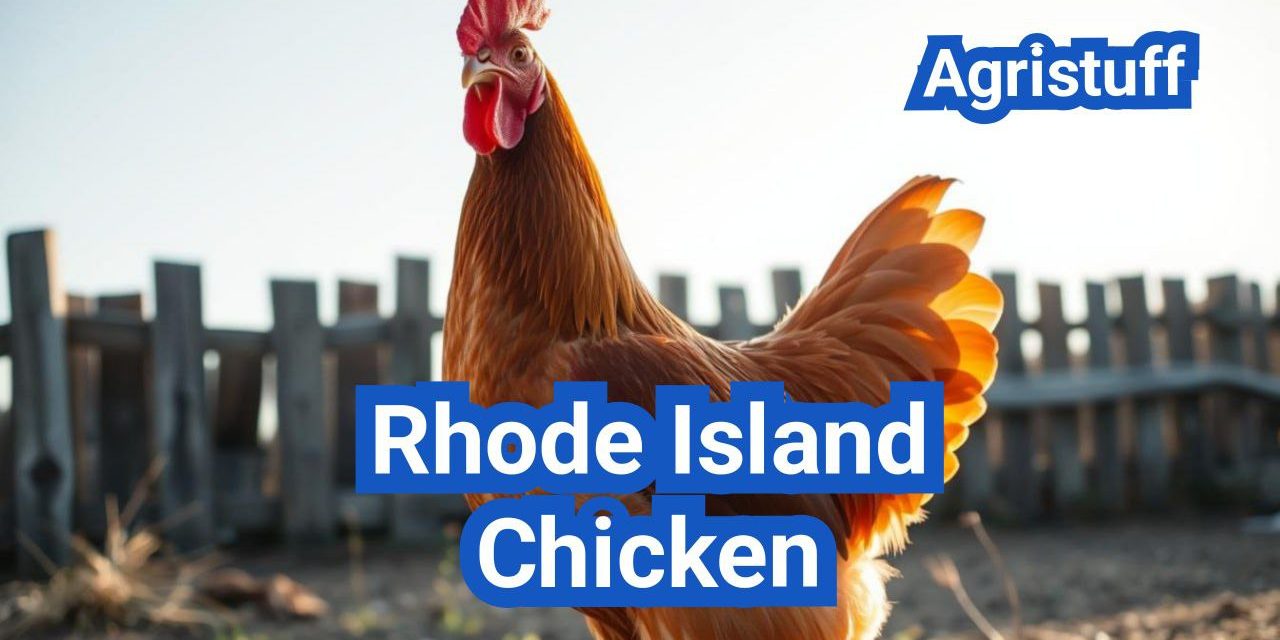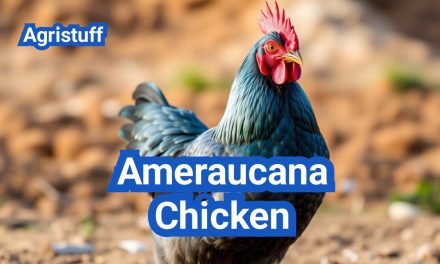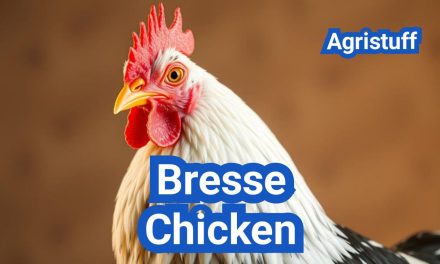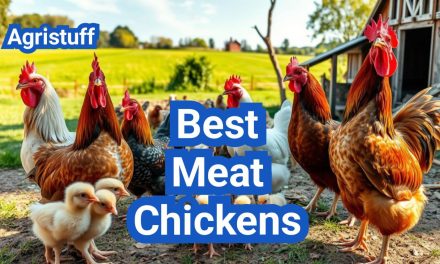The Rhode Island Red is a heritage chicken breed renowned for its exceptional egg-laying abilities and robust nature, making it a favorite among backyard chicken enthusiasts.
Originating in the late 19th century, this breed has been prized for its high egg production and hardiness, characteristics that have cemented its place as a leading choice for those seeking a reliable brown egg layer.
As a dual-purpose breed, they are not only valued for their eggs but also for their meat, offering a versatile option for small farms and backyard flocks.
Key Takeaways
- Rhode Island Reds are known for their high egg production.
- They are a hardy breed, suitable for various climates.
- This breed is considered dual-purpose, providing both eggs and meat.
- Rhode Island Reds are a heritage breed with a rich history.
- They are a popular choice for backyard chicken keepers.
The History and Origin of Rhode Island Chickens
The history of Rhode Island Chickens is a compelling narrative of cross-breeding and selective farming practices in late 19th-century New England. This breed, renowned for its high egg production, was developed primarily in Rhode Island and Massachusetts.
Development in New England
The development of Rhode Island Reds is attributed to the cross-breeding of Oriental and European breeds. Farmers in New England sought to create a dual-purpose chicken that could thrive in the local climate while providing both eggs and meat. “The Rhode Island Red was bred to be a hardy, prolific layer, and its development was a response to the agricultural needs of the time,” notes a poultry expert.
Evolution from a Dual-Purpose Breed
Initially, Rhode Island Reds were valued for both their egg-laying and meat production qualities. However, over time, selective breeding emphasized their egg-laying capabilities, making them one of the most prolific laying breeds. Their ability to produce a high volume of eggs became their most prized characteristic.
Rhode Island’s State Bird Status
In a testament to their significance, Rhode Island Reds were designated as the official state bird of Rhode Island in 1954. This honor reflects not only their historical importance to the state’s agriculture but also their enduring popularity among poultry enthusiasts.
The legacy of Rhode Island Chickens continues to be celebrated today, both for their historical significance and their contribution to modern poultry farming.
Rhode Island Chicken Varieties and Characteristics

Rhode Island Chickens come in several varieties, including Red, White, and Blue, each with its own distinct features. The breed’s diversity is one of its most appealing aspects, offering backyard chicken keepers a range of choices to suit their needs.
Rhode Island Red
The Rhode Island Red is the most well-known variety of the breed. Known for its rich, reddish-brown plumage, this chicken is not only a beautiful addition to any flock but also a prolific egg layer. The Rhode Island Red’s characteristics include its friendly disposition and hardiness, making it a popular choice among chicken enthusiasts.
Rhode Island White
The Rhode Island White is another popular variety, recognized by its elegant white plumage. While it shares many characteristics with the Rhode Island Red, such as its egg-laying abilities and friendly nature, the White variety is distinguished by its pure white color. This makes it a visually appealing choice for those who prefer a lighter-colored chicken.
Rhode Island Blue: A Rare Variant
The Rhode Island Blue is a less common variety, known for its bluish-gray plumage. Although it is not as widely recognized as the Red or White varieties, the Rhode Island Blue offers a unique aesthetic to backyard flocks. Its characteristics are similar to those of the other varieties, with a focus on egg production and a friendly temperament.
The characteristics of these varieties can be summarized in the following table:
| Variety | Plumage Color | Egg Laying Ability | Temperament |
|---|---|---|---|
| Rhode Island Red | Reddish-Brown | High | Friendly |
| Rhode Island White | White | High | Friendly |
| Rhode Island Blue | Bluish-Gray | High | Friendly |
In conclusion, the Rhode Island Chicken breed offers a range of varieties, each with its unique characteristics. Whether you prefer the classic Rhode Island Red, the elegant White, or the rare Blue, there’s a Rhode Island Chicken to suit your needs.
Physical Characteristics of Rhode Island Chickens
Understanding the physical characteristics of Rhode Island Chickens is essential for any poultry keeper. These characteristics not only define the breed but also influence their functionality and adaptability.
Size and Weight Expectations
Rhode Island Reds are considered a medium-sized breed. Hens typically weigh around 6.5 lbs, while roosters can weigh up to 8.5 lbs. This size makes them substantial enough to be considered robust but not so large as to require excessive space.
| Breed | Hens Weight (lbs) | Roosters Weight (lbs) |
|---|---|---|
| Rhode Island Red | 6.5 | 8.5 |
| Bantam Rhode Island Red | 2.5 | 3.0 |
Rose Comb vs. Single Comb Varieties
Rhode Island Reds come in both rose comb and single comb varieties. The rose comb is less prone to frostbite, making it a better choice for colder climates. On the other hand, single comb varieties are often preferred for their traditional appearance.
Rose Comb Advantages: Less susceptible to frostbite, making them suitable for cold climates.
Single Comb Advantages: Often considered more aesthetically pleasing and traditional.
Bantam Rhode Island Reds
Bantam Rhode Island Reds are a smaller version of the standard breed, weighing significantly less. They are ideal for smaller backyard flocks or for those who prefer the characteristics of Rhode Island Reds but in a more compact form.
The bantam version retains many of the characteristics of the standard Rhode Island Red, including their friendly disposition and egg-laying abilities, albeit with smaller eggs.
Temperament and Behavior Traits
Rhode Island Chickens are known for their robust personalities and friendly demeanor, which makes them an excellent addition to any backyard flock. Their temperament is a significant factor in their popularity among poultry enthusiasts.
Personality Characteristics
Rhode Island Reds are particularly noted for their friendly and outgoing personalities. They are generally docile and can be quite curious, often exploring their surroundings with enthusiasm. This breed is known to be quite hardy and assertive, yet they remain friendly and are often described as having a sweet disposition.
Interaction with Other Breeds
Rhode Island Chickens tend to integrate well with other breeds, thanks to their friendly and assertive nature. They can establish a pecking order within the flock but generally do so without being overly aggressive. However, introducing them to other breeds requires careful management to ensure harmony within the flock.
Roosters vs. Hens Behavior Differences
The behavior of roosters and hens can differ significantly. Roosters are typically more assertive and may exhibit protective behavior towards the hens. They can be quite vocal, especially in the morning. Hens, on the other hand, are generally more docile and focused on foraging and egg production. Understanding these differences is crucial for managing a mixed flock effectively.
| Behavior Trait | Roosters | Hens |
|---|---|---|
| Assertiveness | High | Moderate |
| Vocalization | Frequent | Less Frequent |
| Protective Behavior | Strong | Mild |
Why Choose Rhode Island Chicken for Your Backyard Flock

The Rhode Island Chicken breed is a popular choice among backyard flock owners for several reasons. Known for their hardiness, high egg production, and friendly disposition, they offer numerous benefits to those who keep them.
Adaptability to Different Climates
One of the key advantages of Rhode Island Chickens is their adaptability to various climates. They can thrive in both cold and hot weather conditions, making them an ideal choice for backyard flocks across different regions. Their hardiness ensures that they remain productive and healthy regardless of the climate.
Suitability for Beginners
Rhode Island Chickens are also well-suited for beginners. They are relatively easy to care for, requiring minimal specialized knowledge. Their friendly and docile nature makes them a great choice for those new to keeping chickens. Additionally, their high egg production provides a rewarding experience for beginners.
Space Requirements and Considerations
In terms of space requirements, Rhode Island Chickens are relatively low-maintenance. They need enough space to roam and exercise, but they can adapt to a variety of living situations, from larger backyards to smaller spaces, as long as they have adequate shelter and protection. Ensuring that your coop is well-ventilated and secure is crucial for their health and productivity.
Overall, the Rhode Island Chicken breed offers a compelling combination of hardiness, productivity, and ease of care, making them an excellent choice for many backyard flock owners.
Maximizing Rhode Island Chicken Egg Production
To get the most out of your Rhode Island Reds, understanding how to maximize their egg production is crucial. Rhode Island Reds are prolific layers, and with the right conditions, they can produce a significant number of eggs annually.
Average Eggs Per Year: What to Expect
On average, a healthy Rhode Island Red hen can lay between 200 to 300 brown eggs per year. This makes them an excellent choice for backyard chicken keepers looking for a steady egg supply.
Egg Size, Quality and Color
The eggs laid by Rhode Island Reds are typically brown and of medium to large size. The quality and size can be influenced by factors such as nutrition and age of the hen.
Factors Affecting Productivity
Several factors can affect the egg production of Rhode Island Reds, including nutrition, lighting, health, and stress levels. Ensuring that your hens receive a balanced diet and are kept in a stress-free environment can significantly impact their productivity.
Implementing Optimal Lighting Schedules
Lighting plays a crucial role in egg production. As the days get shorter, supplemental lighting can be used to maintain egg production levels. A well-planned lighting schedule can help in maximizing the egg-laying potential of your Rhode Island Reds.
| Factor | Impact on Egg Production | Recommendation |
|---|---|---|
| Nutrition | A balanced diet is crucial for maintaining high egg production. | Provide layer feed that is rich in calcium and protein. |
| Lighting | Adequate lighting is necessary for stimulating egg production. | Ensure 14 hours of light per day, using supplemental lighting as needed. |
| Health | Healthy hens are more productive. | Regular health checks and preventative care are essential. |
By understanding and addressing these factors, you can create an optimal environment for your Rhode Island Reds, maximizing their egg production and enjoying a bountiful supply of fresh eggs.
How to Set Up the Perfect Rhode Island Chicken Coop

To keep your Rhode Island Chickens safe and productive, it’s essential to design a coop that meets their specific needs. A well-planned coop not only ensures the health and happiness of your flock but also maximizes egg production.
Space Requirements and Dimensions
When it comes to housing Rhode Island Chickens, providing adequate space is crucial. The coop should offer at least 3-4 square feet per chicken inside the coop and 8-10 square feet per chicken in the outdoor run. Ensuring sufficient space helps reduce stress among the flock and prevents disease.
Essential Coop Features for Rhode Island Reds
Rhode Island Reds require a coop that is well-ventilated, dry, and draft-free. Essential features include sturdy construction, adequate lighting, and protection from predators. Incorporating windows or vents can enhance ventilation, while a sloping roof helps prevent snow accumulation in colder climates.
Nest Box Ratio and Design
A proper nest box ratio is vital for encouraging egg laying. A general rule of thumb is to provide one nest box for every 3-4 hens. Nest box design should include soft bedding material, such as straw or pine shavings, and be positioned in a quiet, dark area of the coop to simulate a natural nesting environment.
Run Space Considerations
The run area should be securely fenced to protect against predators and prevent escape. Considerations for the run include providing adequate shade, incorporating dust bathing areas, and ensuring easy access to the coop. A well-designed run encourages natural foraging behavior and exercise among the flock.
By focusing on these key aspects, you can create a coop and run system that supports the health, happiness, and productivity of your Rhode Island Chickens.
Feeding Rhode Island Chickens for Maximum Egg Production

The nutritional intake of Rhode Island Chickens directly impacts their ability to lay eggs efficiently. A diet rich in the right nutrients is crucial for maintaining high egg production levels.
Layer Feed Protein Requirements
Rhode Island Chickens, being prolific layers, require a diet that is high in protein to support their egg-laying activities. Layer feed with a protein content of around 16-18% is recommended. This level of protein supports the overall health of the hens and promotes consistent egg production.
According to poultry nutrition experts, “A laying hen’s diet should be formulated to meet her specific nutritional needs, with protein being a critical component.”
“The protein requirement for laying hens is generally higher than that for non-laying hens, as it supports both maintenance and egg production.” – Poultry Nutrition Guide
Calcium Supplementation for Strong Eggshells
Calcium is another critical nutrient for laying hens, as it is essential for the production of strong eggshells. A deficiency in calcium can lead to weak or thin-shelled eggs. Providing crushed oyster shells or dark leafy greens can help meet the calcium needs of Rhode Island Chickens.
| Nutrient | Function | Sources |
|---|---|---|
| Protein | Supports overall health and egg production | Layer feed, mealworms |
| Calcium | Essential for strong eggshells | Crushed oyster shells, dark leafy greens |
Beneficial Treats and Supplements
In addition to a balanced layer feed, Rhode Island Chickens can benefit from certain treats and supplements. Mealworms, for example, are a good source of protein, while sunflower seeds provide healthy fats. However, treats should not make up more than 10% of their daily diet.
Recommended Treats:
- Mealworms
- Sunflower seeds
- Dark leafy greens
Creating an Effective Feeding Schedule
Establishing a consistent feeding schedule is vital for maintaining the health and productivity of Rhode Island Chickens. Hens should have access to feed at all times, and their feeders should be cleaned regularly to prevent spoilage.
Tips for an Effective Feeding Schedule:
- Provide layer feed continuously.
- Supplement with calcium sources in the evening.
- Limit treats to avoid overfeeding.
By focusing on the nutritional needs of Rhode Island Chickens, including layer feed protein requirements, calcium supplementation, beneficial treats, and a well-planned feeding schedule, backyard chicken keepers can maximize egg production and maintain the overall health of their flock.
Rhode Island Chickens as Dual-Purpose Birds

The dual-purpose nature of Rhode Island Chickens makes them an attractive choice for backyard farmers looking to produce both eggs and meat. This breed’s versatility is one of its most significant advantages, allowing poultry keepers to enjoy the benefits of both egg production and meat quality.
Meat Production Qualities
Rhode Island Reds are known for their excellent meat production qualities. They have a plump body and a significant amount of breast meat, making them suitable for the dinner table. The meat is tender and flavorful, characteristics that are highly valued in poultry.
Key Characteristics for Meat Production:
- Plump body
- Significant breast meat
- Tender and flavorful meat
Growth Rate and Development Timeline
The growth rate of Rhode Island Reds is relatively fast, with birds reaching maturity in about 16-20 weeks. This rapid growth, combined with their hardiness, makes them an efficient choice for meat production.
| Age (Weeks) | Weight (lbs) | Development Stage |
|---|---|---|
| 0-4 | 0.5-1.5 | Brooding |
| 4-12 | 1.5-4.0 | Growing |
| 12-20 | 4.0-7.0 | Maturation |
Comparing Egg vs. Meat Production Value
Rhode Island Chickens are prolific egg layers, producing an average of 200-220 brown eggs per year. When considering their dual-purpose use, it’s essential to weigh the value of egg production against meat production. For many backyard farmers, the ability to enjoy both eggs and meat from the same breed is a significant advantage.
Egg production vs. Meat production: While egg production is a steady income stream, meat production offers a tangible product for consumption or sale. The decision between focusing on eggs or meat often depends on the farmer’s goals and market demand.
In conclusion, Rhode Island Chickens offer a unique combination of egg and meat production capabilities, making them a valuable choice for those looking to diversify their poultry output.
Seasonal Care Guide for Rhode Island Chickens

The changing seasons bring different challenges for Rhode Island Chicken keepers, requiring specific care adjustments. To ensure the health and productivity of your flock, it’s crucial to understand and implement seasonal care strategies.
Winter Care Requirements and Preparations
During the winter months, Rhode Island Chickens need protection from cold temperatures. Ensuring their coop is well-insulated and draft-free is essential. Adding extra bedding like straw can help keep the coop warm. It’s also vital to provide adequate ventilation to prevent moisture buildup, which can lead to respiratory issues.
Key Winter Care Tips:
- Ensure the coop is well-insulated and draft-free.
- Provide extra bedding to keep the coop warm.
- Maintain adequate ventilation to prevent moisture buildup.
- Offer warm water and nutrient-rich feed to support their health.
Summer Heat Management Strategies
Rhode Island Chickens can be susceptible to heat stress during the summer. Providing shade, ensuring good ventilation, and offering cool water are critical. You can also use cooling measures like misting systems or fans in the coop to keep your chickens cool.
Summer Heat Management Tips:
- Provide shade and ensure good ventilation in the coop.
- Offer cool, fresh water at all times.
- Use cooling measures like misting systems or fans.
- Monitor your chickens for signs of heat stress.
| Season | Care Requirements | Key Considerations |
|---|---|---|
| Winter | Insulation, extra bedding, ventilation | Prevent drafts, moisture buildup |
| Summer | Shade, ventilation, cooling measures | Monitor for heat stress, provide cool water |
Supporting Your Flock During Molting Season
Molting season, typically occurring in the fall, can be a stressful period for Rhode Island Chickens. During this time, they shed their feathers and regrow new ones. Providing a nutrient-rich diet, especially with high protein content, can support their health and help them recover more quickly.
Molting Season Care Tips:
- Provide a nutrient-rich diet with high protein content.
- Ensure access to fresh water and a balanced feed.
- Reduce stress by maintaining a calm environment.
- Monitor their health and adjust care as necessary.
By following these seasonal care guidelines, you can help ensure your Rhode Island Chickens remain healthy and productive throughout the year.
Health Management and Disease Prevention

The health and wellbeing of Rhode Island Chickens depend on a comprehensive approach to disease prevention and health management. While they are known for their robust nature, implementing effective health strategies is crucial for maximizing their productivity and longevity.
Natural Disease Resistance Advantages
Rhode Island Chickens are recognized for their natural resistance to certain diseases, making them a hardy choice for backyard flocks. This innate resistance is one of the breed’s significant advantages, reducing the need for extensive medical interventions. However, it’s essential to complement this natural resilience with proper care and management practices.
Common Health Concerns to Watch For
Despite their natural disease resistance, Rhode Island Chickens can be susceptible to common poultry health issues such as respiratory infections, parasites, and reproductive problems. Regular monitoring and maintaining a clean living environment are critical steps in preventing these issues. Vaccination and parasite control measures should be considered as part of a comprehensive health management plan.
Preventative Care Schedule
Implementing a preventative care schedule is vital for the health of your Rhode Island Chickens. This includes regular checks for signs of illness, maintaining a clean coop, and providing a balanced diet rich in necessary nutrients. Calcium supplementation is particularly important for hens to ensure strong eggshell production.
Expected Lifespan and Productivity Duration
Rhode Island Chickens are known for their high egg production, which can last for several years. On average, a healthy Rhode Island Red hen can lay eggs consistently for about 5 to 7 years, although their productivity may decrease with age. Proper health management can help extend their productive lifespan.
By focusing on health management and disease prevention, you can ensure your Rhode Island Chickens lead healthy, productive lives, providing you with a bountiful supply of eggs for years to come.
How to Breed Rhode Island Chickens Successfully

Breeding Rhode Island chickens requires careful planning and a thorough understanding of the breed’s characteristics. To achieve success, breeders must focus on several key areas.
Selecting Quality Breeding Stock
The foundation of a successful breeding program is selecting quality breeding stock. This involves choosing birds that embody the breed’s standard characteristics, such as robust health, high egg production, and the desired temperament. When selecting breeding stock, it’s essential to look for birds with good conformation, vibrant plumage, and a friendly disposition.
Maintaining Heritage Breed Qualities
Maintaining the heritage qualities of Rhode Island chickens is crucial for preserving the breed’s integrity. This involves understanding the breed’s history and adhering to its standard characteristics. Breeders should focus on traits such as egg-laying ability, meat production, and foraging capability. By doing so, they can ensure that their flock remains true to its heritage.
Hatching and Brooding Rhode Island Chicks
The process of hatching and brooding Rhode Island chicks requires careful attention to detail. Incubation conditions must be optimized to ensure high hatch rates, and brooding conditions should be designed to promote healthy growth. This includes maintaining appropriate temperatures, providing adequate nutrition, and ensuring a clean environment.
By following these guidelines, breeders can successfully breed Rhode Island chickens, maintaining the breed’s heritage qualities while producing healthy, productive birds.
Step-by-Step Guide to Raising Rhode Island Chicks

To successfully raise Rhode Island Red chicks, one must understand the intricacies of their early development stages. This guide will walk you through the essential steps, from setting up a proper brooding environment to integrating your pullets into the laying flock.
Brooding Setup and Requirements
A proper brooding setup is crucial for the survival and healthy development of Rhode Island Red chicks. The brooder should be clean, dry, and draft-free. Use a heat lamp or heating pad to maintain a temperature of around 90-95°F for the first week, gradually decreasing it by 5°F each subsequent week until you reach around 70-75°F.
Essential Brooding Equipment:
- Heat lamp or heating pad
- Thermometer
- Brooder bedding (pine shavings or straw)
- Feeder and waterer
Week-by-Week Growth Expectations
Understanding the growth milestones of your Rhode Island Red chicks helps in identifying any potential issues early on. Here’s a week-by-week overview:
| Week | Expected Development | Care Tips |
|---|---|---|
| 1 | Chicks are fully dependent on the heat source; feathers start to appear. | Monitor temperature closely; ensure access to starter feed and fresh water. |
| 2-3 | Feathering becomes more pronounced; chicks start to venture out. | Introduce perches; continue to adjust temperature. |
| 4-5 | Chicks are more active; feathers cover most of the body. | Gradually introduce pullet grower feed; expand living space if necessary. |
Transitioning Pullets to the Laying Flock
As your pullets mature, typically around 18-20 weeks, it’s time to integrate them into the laying flock. Ensure the coop is ready with adequate nesting boxes and sufficient space to accommodate the new additions.
Tips for Successful Integration:
- Introduce pullets to the coop in the evening to reduce stress.
- Monitor for signs of aggression or stress among the existing flock.
- Ensure there’s enough space and resources for all birds.
Implementing Proper Biosecurity for Your Flock
Effective biosecurity practices are essential for the health and productivity of your chicken flock. Biosecurity refers to the measures taken to prevent the introduction and spread of diseases within your flock. By implementing rigorous biosecurity protocols, you can significantly reduce the risk of disease outbreaks.
Disease Prevention Strategies
Disease prevention is a critical aspect of biosecurity. This involves not only protecting your flock from external disease sources but also maintaining internal health standards. Key strategies include:
- Regular cleaning and disinfection of the coop and equipment
- Controlling access to the coop and run area
- Monitoring flock health daily
Quarantine Procedures for New Birds
Introducing new birds to your flock can pose a significant disease risk if not managed properly. Quarantine procedures are vital to ensure that new birds do not introduce diseases to your existing flock.
| Quarantine Measure | Description | Duration |
|---|---|---|
| Isolation | Keep new birds separate from the rest of the flock. | At least 30 days |
| Health Monitoring | Observe new birds for signs of illness. | Throughout quarantine |
| Testing | Conduct health tests as recommended by a veterinarian. | Before releasing from quarantine |
NPIP Certification Importance
The National Poultry Improvement Plan (NPIP) is a cooperative state-federal program aimed at controlling and eradicating certain poultry diseases. NPIP certification is crucial for breeders and backyard flock owners alike, as it ensures that your flock is free from specific diseases.
Benefits of NPIP Certification:
- Enhanced biosecurity
- Improved flock health
- Better marketability of birds
By understanding and implementing these biosecurity measures, you can protect your flock from diseases and ensure their overall health and productivity.
Where to Buy Rhode Island Chickens and What They Cost
For those interested in acquiring Rhode Island Chickens, understanding the options and associated costs is crucial. Potential buyers have two primary sources to consider: reputable hatcheries and local breeders.
Reputable Hatcheries vs. Local Breeders
Reputable hatcheries offer a convenient way to purchase Rhode Island Reds, often with the assurance of healthy, vaccinated birds. They typically provide a wide selection of breeds and ages, including day-old chicks, pullets, and laying hens. Local breeders, on the other hand, can offer more personalized service and potentially more specific breed characteristics. They may also provide valuable insights into the birds’ temperaments and egg-laying capabilities.
When choosing between a hatchery and a local breeder, consider factors such as:
- The health guarantees they offer
- Their breeding practices and priorities
- Any additional services, like delivery or starter kits
- Their reputation within the poultry community
Average Price Points and Value Considerations
The cost of Rhode Island Chickens can vary significantly based on factors like age, quality, and lineage. Day-old chicks from a reputable hatchery might cost between $3 to $5 per chick, while pullets or laying hens can range from $20 to $50 or more per bird, depending on their quality and breeding.
When evaluating the cost, consider the long-term value:
- The potential for high egg production
- The bird’s expected lifespan and health
- Any additional costs, such as feed and housing
What to Look for When Purchasing Quality Stock
Regardless of whether you choose a hatchery or a local breeder, there are several key factors to consider when purchasing Rhode Island Reds. Look for birds that appear healthy and active, with clear eyes, clean feathers, and no signs of injury or illness.
Key characteristics of quality Rhode Island Reds include:
| Characteristic | Description |
|---|---|
| Vibrant Plumage | A rich, deep red color indicative of the breed standard |
| Robust Health | Signs of vitality, such as bright eyes and active behavior |
| Good Temperament | A friendly, docile nature, especially in hens |
By carefully considering these factors and understanding the associated costs, you can make an informed decision when buying Rhode Island Chickens for your backyard flock.
The Enduring Appeal of Rhode Island Chickens
The Rhode Island Chicken remains a beloved breed among backyard flock owners due to its exceptional hardiness and high egg production. The Rhode Island Red appeal lies in its friendly nature, making it an ideal choice for families and beginners.
One of the primary benefits of raising Rhode Island chickens is their ability to thrive in various climates, adapting seamlessly to different environments. Their robust health and resistance to disease reduce the need for extensive veterinary care, making them a practical choice for many.
With their rich history, impressive egg-laying capabilities, and affectionate personalities, it’s no wonder Rhode Island Chickens continue to be a popular choice. Whether you’re a seasoned poultry keeper or just starting out, these remarkable birds are sure to bring joy and productivity to your backyard flock.
FAQ
What is the average egg production of Rhode Island Chickens per year?
Rhode Island Chickens are known for their high egg production, laying around 200-220 brown eggs per year.
What are the different varieties of Rhode Island Chickens?
The main varieties of Rhode Island Chickens are the Rhode Island Red, Rhode Island White, and Rhode Island Blue, each with distinct characteristics.
What is the difference between rose comb and single comb Rhode Island Reds?
Rose comb Rhode Island Reds have a comb that is shaped like a rose, while single comb varieties have a single, upright comb. The rose comb is less prone to frostbite.
Are Rhode Island Chickens suitable for beginners?
Yes, Rhode Island Chickens are a great choice for beginners due to their hardiness, friendly temperament, and high egg production.
How much space do Rhode Island Chickens require?
Rhode Island Chickens need about 3-4 square feet of space per bird inside the coop, and at least 8-10 square feet per bird in the run.
What are the nutritional needs of Rhode Island Chickens for maximum egg production?
Rhode Island Chickens require a balanced diet that includes layer feed with 16-18% protein, calcium supplementation, and beneficial treats and supplements.
How can I maximize egg production from my Rhode Island Chickens?
To maximize egg production, provide optimal lighting schedules, a balanced diet, and ensure the coop is well-ventilated and clean.
Can Rhode Island Chickens be used for meat production?
Yes, Rhode Island Chickens can be used for meat production, and they are considered a dual-purpose breed. They have a moderate growth rate and are suitable for small-scale meat production.
How do I care for Rhode Island Chickens during extreme weather conditions?
During winter, ensure the coop is well-insulated and provide extra nutrition. In summer, provide shade, ventilation, and plenty of water to keep the birds cool.
What are the common health concerns for Rhode Island Chickens?
Rhode Island Chickens are generally hardy, but they can be susceptible to diseases such as coccidiosis and respiratory infections. Regular health checks and preventative care can help minimize these risks.
How long do Rhode Island Chickens live?
Rhode Island Chickens can live for around 8-10 years, with some hens continuing to lay eggs well into their old age.
Where can I buy Rhode Island Chickens?
You can buy Rhode Island Chickens from reputable hatcheries, local breeders, or online suppliers. Make sure to research the seller and check the health and quality of the birds before purchasing.
What is the importance of NPIP certification for Rhode Island Chickens?
NPIP certification ensures that the birds are free from certain diseases, such as salmonella and mycoplasma. This certification is important for maintaining flock health and preventing disease introduction.
How do I breed Rhode Island Chickens successfully?
To breed Rhode Island Chickens successfully, select quality breeding stock, maintain the heritage breed qualities, and follow proper hatching and brooding procedures.
Conclusion of: Rhode Island Chicken
Why the Rhode Island Chicken is a proven, all-round performer
The Rhode Island Chicken (commonly known as Rhode Island Red) is celebrated by American backyard keepers for its rugged constitution, consistent brown eggs, and ease of care. From suburban coops to small homesteads, the Rhode Island Chicken reliably turns balanced feed and good management into year-round cartons, making it a smart choice for beginners and experienced flock owners alike. Livestock Conservancy breed profile
Origin & development in New England
Bred along the coastal communities of Rhode Island and Massachusetts in the late 1800s, the Rhode Island Chicken traces its roots to practical farmers crossing utility birds like Malay and Brown Leghorn to create a tough, dual-purpose strain. That New England origin matters: the Rhode Island Chicken was selected for real-world conditions—salt-air winters, variable feed quality, and farmyard resilience—traits it still displays today. University of Wisconsin Extension overview
Official recognition & breed standards
The American Poultry Association accepted the single-comb Rhode Island Chicken in 1904 and the rose-comb in 1905, establishing the breed’s conformation and color standard for exhibition and breeding. While exhibition strains can emphasize show qualities, production-oriented lines of Rhode Island Chicken are selected primarily for lay rate and efficiency—both approaches remain true to the breed’s legacy. American Poultry Association (APA)
Identifying a true Rhode Island Chicken (conformation & color)
Look for a rectangular, brick-shaped body; rich mahogany to dark red plumage (often with some black in tail and wings); yellow legs and skin; and either a single or rose comb. Standard mature weights for Rhode Island Chicken are typically around 8–8.5 lb for roosters and 6–6.5 lb for hens, with medium-to-large brown eggs. These markers help distinguish authentic Rhode Island Chicken lines from similarly colored hybrids. Oklahoma State University breed profile
Temperament & hardiness you can depend on
Selected for utility, the Rhode Island Chicken is typically calm, confident, and resilient under backyard conditions. Hens are steady foragers that handle variable weather and routine management well. While individual roosters of any breed can be assertive, many keepers find the Rhode Island Chicken a practical, low-maintenance companion compared with more delicate layers. University of Minnesota Extension: Raising Chickens for Eggs
Egg production: realistic numbers for Rhode Island Chicken
Under good nutrition and lighting, a Rhode Island Chicken hen commonly lays about 200–280 brown eggs per year, with many household flocks averaging near the middle of that range. Differences among hatchery strains, management, climate, and age will shift outcomes, but the Rhode Island Chicken is widely regarded as one of the most dependable brown-egg layers for small flocks. University of New Hampshire Extension: Producing Your Own Eggs
Heritage lines vs. production strains of Rhode Island Chicken
“Heritage-type” Rhode Island Chicken lines prioritize classic body type and color, while commercial lines favor higher lay. Expect heritage birds to mature a bit heavier with modestly lower annual egg counts, and production strains to be slightly trimmer with higher output. Choosing the right Rhode Island Chicken strain depends on whether your priority is traditional conformation or maximum eggs. OSU: Rhode Island Red (breed details)
Dual-purpose value of Rhode Island Chicken (eggs + table bird)
As a dual-purpose mainstay, the Rhode Island Chicken offers steady brown eggs and a well-fleshed carcass, fitting homesteads that want one breed to “do both.” While elite layer breeds can outpace it on eggs alone, and specialized meat hybrids outgrow it for broilers, the Rhode Island Chicken provides balanced utility with fewer trade-offs. UW Extension: Historical context
Housing & space that keep Rhode Island Chicken productive
Provide roughly 3–5 ft² of indoor coop space per bird, dry bedding, draft-free ventilation, and predator-secure construction. Rhode Island Chicken flocks benefit from shade in summer and wind protection in winter; clutter-free traffic flow around feeders and drinkers reduces stress, protecting lay rate. A small, covered run helps keep Rhode Island Chicken feet and feathers clean in wet climates. UMN Extension: Housing & basics
Nest boxes & roosts for the Rhode Island Chicken
Aim for one nest box per 4–5 hens, placed below roost height to discourage sleeping in nests. Dry, cushioned bedding cuts down on cracked or dirty eggs, and solid perches (about 2″ wide) let the Rhode Island Chicken roost securely with minimal foot strain. Good nesting setups reduce floor-laying and keep the Rhode Island Chicken’s egg quality high. Virginia Tech: Small-Scale Poultry Housing
Lighting schedule to maintain year-round eggs
To sustain lay through short days, gradually extend total daylength to ~16 hours using a timer and low-intensity light. Increase no more than 30 minutes per week to avoid stress. The Rhode Island Chicken responds well to consistent photoperiod; overstimulation can backfire, but steady 14–16 hours supports healthy, reliable production. Penn State Extension: Small-Scale Egg Production
Feeding the Rhode Island Chicken: protein, energy & timing
Transition pullets to a complete layer ration (about 16% crude protein) near first lay, ensuring constant access to clean water. The Rhode Island Chicken thrives on consistent nutrition; scattering scratch as a treat is fine, but the base should remain a balanced feed to protect egg size, shell quality, and hen health. Oregon State University: How to Feed Your Laying Hens
Calcium strategy for strong shells in Rhode Island Chicken
Shell formation demands calcium. Feed formulated layer diets (typically 3–4% Ca) and offer free-choice oyster shell so high-producing Rhode Island Chicken hens can self-regulate intake. Avoid high-calcium feed for chicks and growers to protect kidneys and bone development—save it for layers only. Poultry.Extension.org: Feeding for Egg Production
Cold weather care & summer heat for Rhode Island Chicken
The Rhode Island Chicken is naturally cold-hardy, but frostbite risk rises with damp litter and poor ventilation. Keep coops dry with ample, draft-free airflow and consider petroleum jelly on large combs in extreme cold. In summer, add shade, cool water, and midday ventilation to prevent heat stress so the Rhode Island Chicken maintains appetite and egg output. UMN Extension: Cold-Weather Care
Biosecurity & flock health for Rhode Island Chicken
Practice strong biosecurity: quarantine new birds, limit visitor traffic, clean equipment, and reduce contact with wild birds. These habits lower the odds of avian influenza and common bacterial challenges. A clean, closed flock helps the Rhode Island Chicken express its full productivity without disease setbacks. USDA APHIS: Defend the Flock
Vaccination & sourcing quality Rhode Island Chicken stock
Many hatcheries vaccinate chicks against Marek’s disease at day-old; if yours do not, consult a poultry-savvy veterinarian about options. When buying, prefer reputable sellers that participate in NPIP programs to reduce the risk of vertically transmitted disease. Clear strain information helps match the Rhode Island Chicken to your goals (heritage vs. production). National Poultry Improvement Plan (NPIP)
Is the Rhode Island Chicken right for you?
If you want a hardy, low-maintenance brown-egg layer with true American heritage, the Rhode Island Chicken is hard to beat. It tolerates varied climates, makes efficient use of complete feeds, and remains forgiving of minor husbandry mistakes—a practical combination for families, schools, and homesteads that value reliable production. OSU: Rhode Island Red breed details
Final thought
The enduring popularity of the Rhode Island Chicken comes from performance you can measure—steady eggs, sturdy birds, and simple care routines. Pair good housing with a 14–16-hour light schedule and balanced feed, and the Rhode Island Chicken will reward you with dependable cartons through the seasons. Penn State Extension: Management guidance
Sources & References
- The Livestock Conservancy — Rhode Island Red
- Oklahoma State University — Breeds of Livestock: Rhode Island Red
- American Poultry Association — Official site
- University of New Hampshire Extension — Producing Your Own Eggs
- University of Minnesota Extension — Raising Chickens for Eggs
- Virginia Tech — Small-Scale Poultry Housing
- Penn State Extension — Small-Scale Egg Production
- Oregon State University — How to Feed Your Laying Hens
- Poultry.Extension.org — Feeding Chickens for Egg Production
- University of Minnesota Extension — Caring for Chickens in Cold Weather
- USDA APHIS — Defend the Flock (Biosecurity)
- NPIP — National Poultry Improvement Plan










